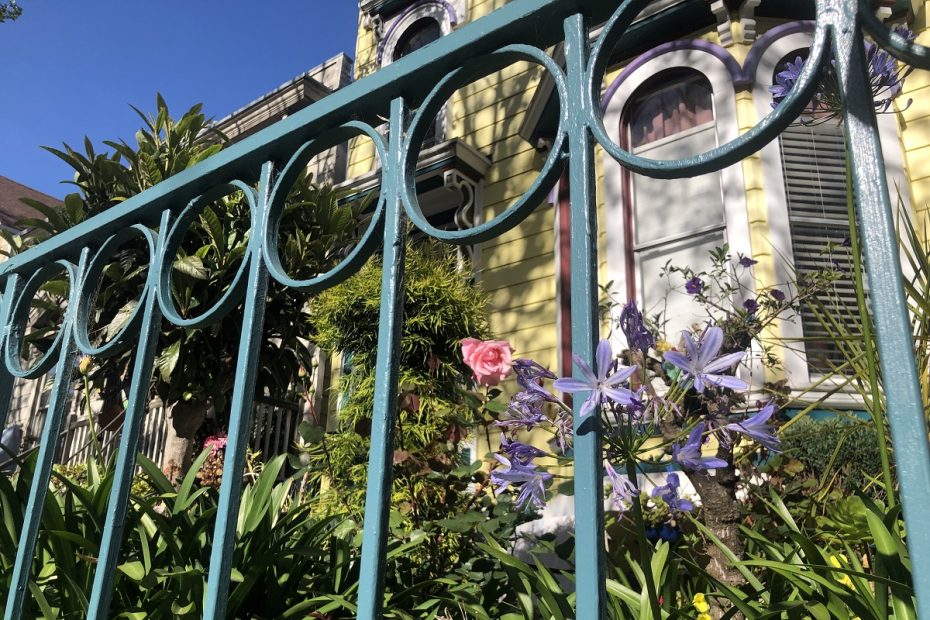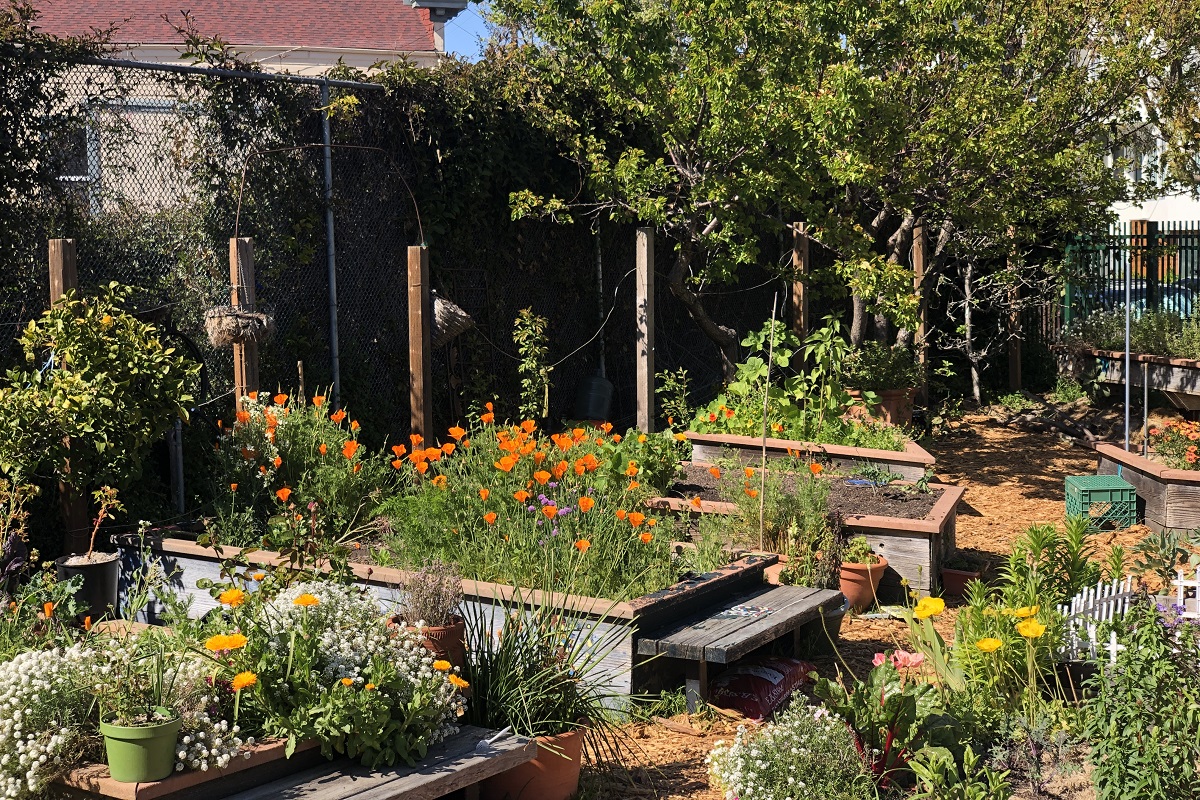Patches of golden poppies, purple-headed lupine bushes, fields of yellow buttercups: The Mission is filling up with wildflowers, part of the San Francisco superbloom following the city’s third-wettest winter on record.
Some clusters sprout up around sidewalk trees, others reach out from Victorian front yards, while still others decorate the ample medians on streets like Guerrero.
Mission Local recently photographed several gardens in the neighborhood: Community gardens, fenced-off areas hidden in parks and playgrounds, and sidewalk gems cared for by neighbors.
While some thrive with care from local stewards, others remain barren. The ownership and funding of each garden varies, as there are at least five nonprofits and city departments that oversee green space.
“Community interest and neighborhood interest is the primary factor” to get a garden, said Brian Wiedenmeier, executive director of Friends of the Urban Forest, which has helped install more than 1,400 sidewalk gardens across the city. “And then, of course, we need to make sure that if we’re removing concrete from the sidewalk, there’s enough space to maintain the travel pathway.”

Sidewalk gardens free for many
A sidewalk garden can be installed free-of-cost for homeowners. Now, the project is completely free for the adjacent property owners in District 8 and 11, encompassing the Castro, Noe Valley, Outer Mission, Ingleside, and Exelsior. The city’s Environment Department, the Public Utilities Commission and budget set-asides from city supervisors cover the bill.
A 72-inch-wide minimum unobstructed path is required for most sidewalks, with some exceptions for narrow residential and alleyway sidewalks, according to the city’s Bureau of Urban Forestry.
In the first four months this year, Friends of the Urban Forest received 30 requests for new sidewalk gardens. Wiedenmeier said they consider community input when deciding on which species to plan, but often stick to their expertise based on each neighborhood’s unique microclimate: Yarrow, Foothill penstemon, California fuchsia, baby sage and common rush are the top five plant species commonly included in the sidewalk gardens.
Once a sidewalk garden is installed, its maintenance becomes the property owners’ responsibility. “Sometimes, when we notice that a particular sidewalk garden isn’t doing well, we have contacted the adjacent property owner with suggestions. In other cases, we have seen gardens that are tended quite beautifully, and that look even better now than when they were first created,” replied Ben Carlson, the spokesperson of Friends of the Urban Forest.
“I think that gardens and trees are green infrastructure for a city, and they’re going to help San Francisco become or continue to be climate-resilient in the face of all of the extreme weather that we’ve been having,” said Wiedenmeier, adding that more green space and less concrete can mitigate stormwater runoff and flooding.
As for other parts of the city, San Francisco Public Works has issued permits for sidewalk landscaping. As of July, 2022, the application fee for individual request per property is $322, with slightly lower fees for joint requests. If two to four neighboring properties within the same block or intersection apply, the fee is $277, and if five or more neighbors apply, the fee lowers to $239.
After submitting an application including a detailed location description and a plant list, a re-construction site inspection will be conducted by Public Works staff.
Raul Leon, who lives near 23rd and Shotwell, built two sidewalk gardens in front of his place with three neighbors. “There were no plants at first, and people just used it for garbage,” said Leon, “So we decided to build the metal boxes. Now the street is much cleaner.”
Last year, there was a conversation between residents putting out the planters to discourage encampments and homeless advocates. While neighbors called the planters “defensive architecture” to express their frustration against the city’s inaction on encampments, homeless advocates refer to them as a form of “hostile architecture,” a design strategy that targets groups that rely on public space.

Community gardens
Unlike sidewalk gardens, which can be initiated by a single homeowner, community gardens usually involve several neighbors contacting the city to receive financial support.
Sarah Katz-Hyman, the community partner network manager of the San Francisco Parks Alliance, said most community gardens start with a group of neighbors coming together to create a communal space.
“It offers an opportunity for folks to be able to have some garden plots, some personal vegetables. And, as far as funding is concerned, it really depends, group to group,” said Katz-Hyman. Her group, San Francisco Parks Alliance, offers fiscal sponsorship opportunities to different community groups, with which they can take tax deductible donations or apply for grants. This model is very common among park nonprofits.
Now, the parks alliance works closely with around 15 community gardens citywide, including the Connecticut Friendship Garden on Potrero Hill, Far Out West Community Garden in Outer Sunset.
Other community gardens are less official. The hotly-contested parcel 36, between 22nd and 23rd streets and Harrison Street and Treat Avenue, is partly claimed by several local groups, including gardeners, a preschool and a local business. Mission Greenway, a somewhat guerrilla gardening group, has cut locks to fences and installed planters on the seemingly unowned land, growing tomatoes, strawberries, and other edibles.
In total, there are about 100 community gardens in San Francisco, according to the San Francisco Recreation and Park Department, which oversees 40 of them in city parks. Others are under the federal jurisdiction, like Golden Gate National Recreation Area, and the school district.
Design by Will Jarrett.


Nice article, Mission Local!
I’ve been a Dearborn Gardener for over 25 years, simply because it is one of the sweetest spots int the City, and you can grow (almost) anything there.
If you know anything about plants and gardening, you can grow prickly pear cactus, artichokes, eggplant, lemon and plums. Also, most flowers…
I have to agree (and disagree) with MS: Many plots lie fallow, because, simply, many people love the IDEA of gardening, but find it hard to maintain over a period of time, meaning regular visits for watering, planting, upkeep, etc.
Urban gardening is not easy.
Parking can be a problem. (I cycle, mostly, except when I have big stuff to carry.)
Theft is unfortunately a reality, along with just plain vandalism.
There can be a lack of diversity, and sometimes issues with finances for planting, or upkeep.
It would be definitey great if more people had access to otherwise wasted space for gardens. We all need green spaces, preferably free, and the more the merrier.
Great map but more should be said about the fundamental inequity of access to gardening spaces in SF, particularly for renters, who cannot start sidewalk gardens. Waitlists for community gardens are all 5-10 years, if not longer, while too often, those who are lucky enough to have obtained plots let them lie fallow, like vacant apartments kept off the market. Then there’s the wide disparity, from one community garden to another, in plot size (compare Alioto mini-park to the Potrero-McKinley gardens), bathroom access and security (compare Alioto to Treat Commons Community Garden- the gardeners at Alioto regularly have to remove human feces and trash from their space). Rec and Park has done an abysmal job in ensuring fair access and maintenance of community gardens throughout the City.
I love this piece on the gardens of SF! But there was a Park and Rec community garden left out of the ones in the Mission – Potrero Del Sol! It’s huge and sunny and I gardened there for 5 years. I have so much love for that garden, it’s full of diverse gardeners and plants and it has a storied history. It’s also under threat having a housing development block the sunlight necessary to sustain the garden.
https://www.foundsf.org/index.php?title=The_Farm
https://pdsgarden.org/
https://missionlocal.org/2022/08/shadows-on-potrero-park-del-sol-wont-halt-housing/
I’ve been on a waiting list for spot in Dearborn garden for well over a decade. Now I’m not able to garden due to health, so I guess someone will get my spot in 10 years. LOL
My neighborhood did the sidewalk gardens and nearly every neighbor opened their tree wells and now we have beautiful gardens all along the block. Though plant thieves suck, they stole bromeliads and just stole my next door neighbors Japanese maple that he put out there.
Wow, this was an amazing piece! Thank you for creating it.
Awesome visualization with the 3D fly over map!
Awesome article I forgot I was on Missonlocal felt like it was chronicle story